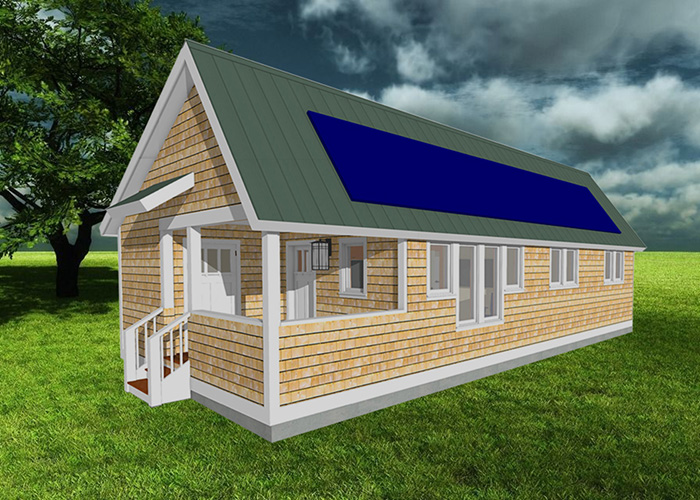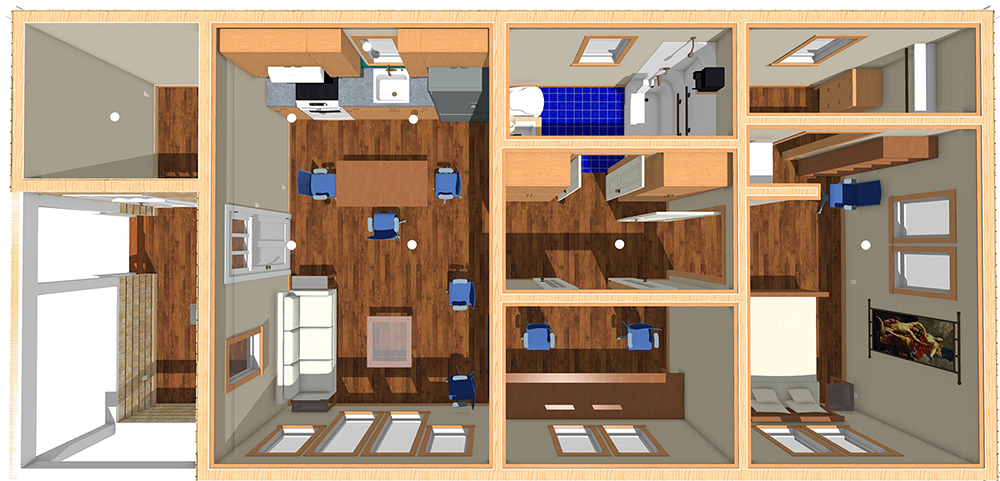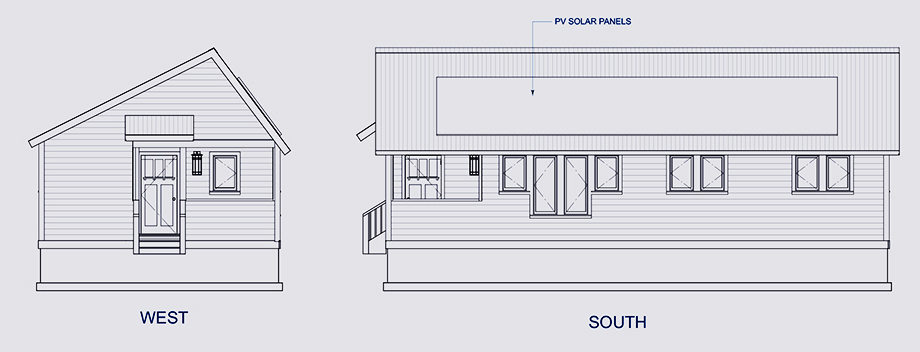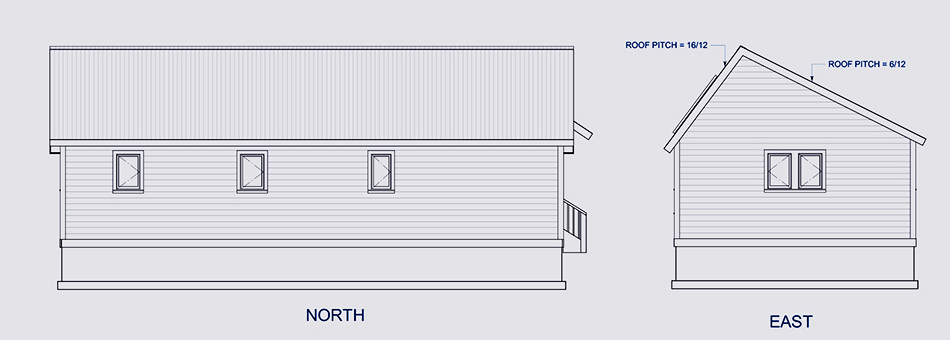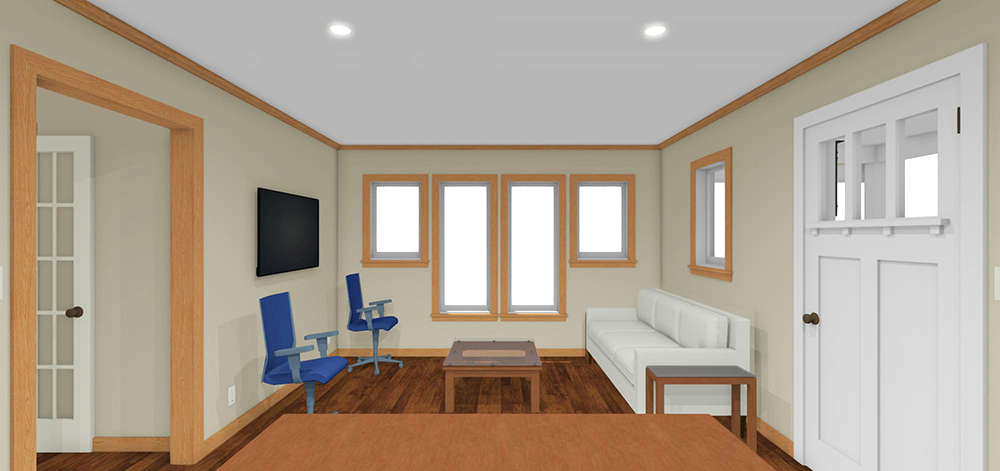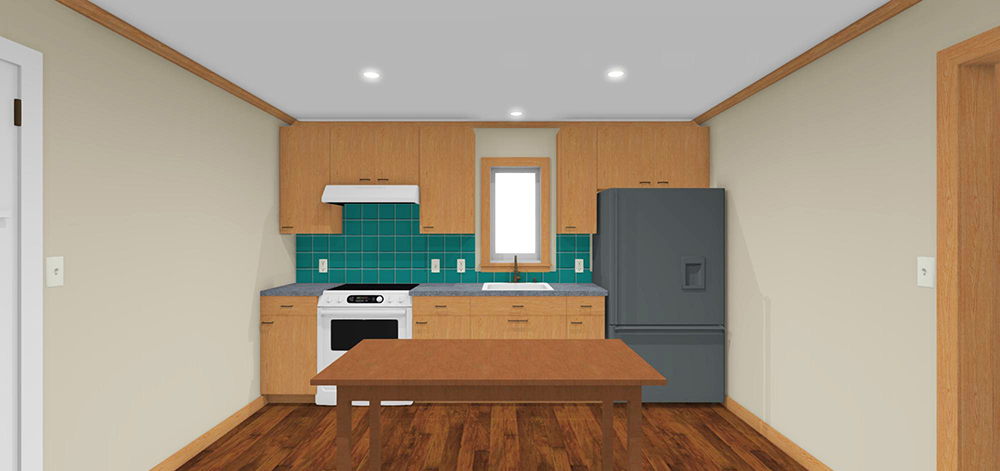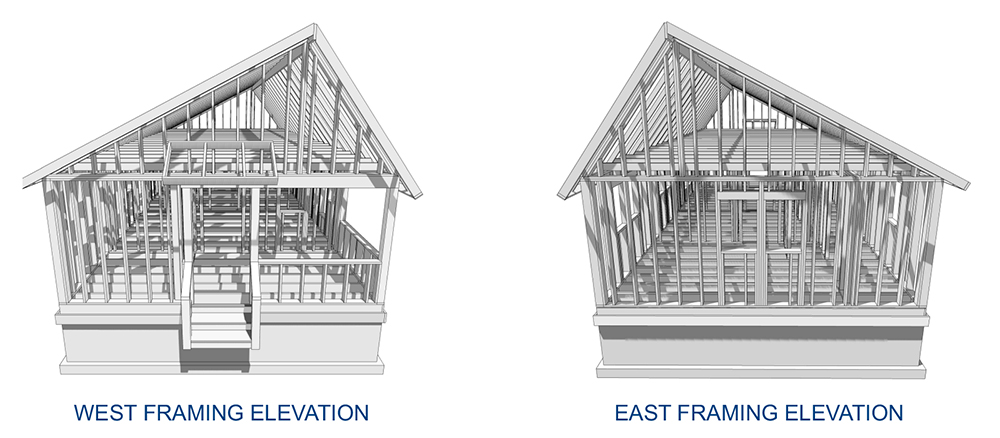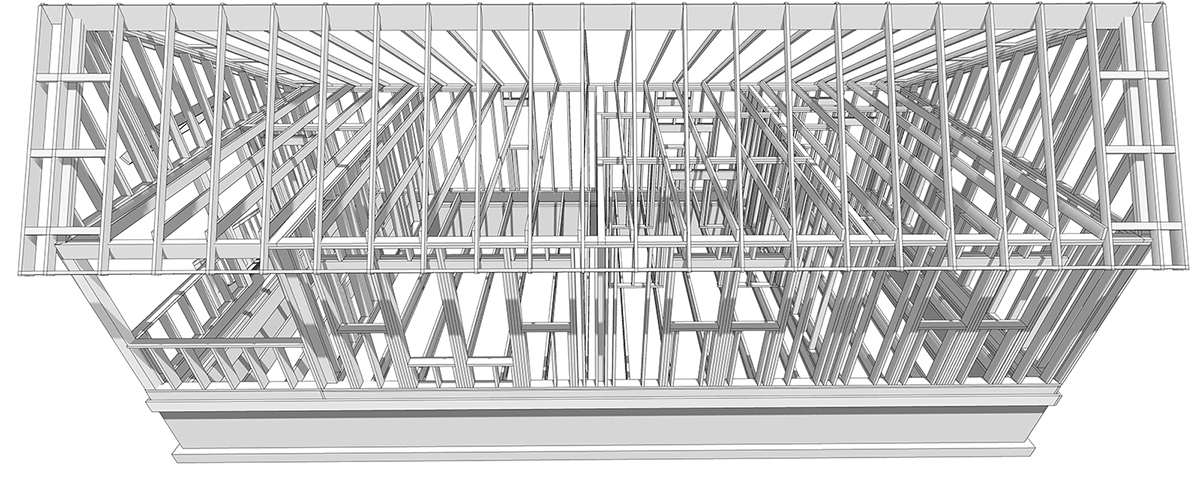SunJazz 840 2B Solar Cottage
More Than a Tiny House!
How about a 2 bedroom home of 840 SF that has off-grid, photovoltaic solar electricity and heating, on a budget of $150,000 to break ground, build it, and move in. Now add all the basics of contemporary life in a floor plan that feels spacious, never wastes space, and accommodates typical furnishings. Most of the glass is on the south. The south roof would carry the solar panels. If the south is on the other side, tilt the roof the other way. In a mostly hot climate, most of the glass would face north.
Accommodations
The SunJazz 840 design has one story, similar to what we call a ranch here on the East Coast. The heat can be distributed through with radiant floor tubing or forced hot air or hidden, tubed baseboard. There are many ways to heat a house. The kitchen is modeled after the best city apartment kitchens designed today, with room for an 18 inch dishwasher, although I believe dishwashers are a waste of energy and water. I cleaned dishes for a family of four for 30 years without one and it was easier.
The front entry will be a 90 square foot open or screened porch with room for a table and chairs. At the end of the porch is the utility room, sealed off with it’s own exterior door. The front door opens to a space between the living room and kitchen where you can see right through to the other side of the house and out the window. There is also the option to open raise the ceiling up to the roof for an atrium effect for a more spacious experience.
This house is conceivably wheelchair accessible with a ramp at the entry. The hallway in the center doubles as a generous pantry for storing food, cooking tools, and even books and small portable appliances. There is a storage space in the attic accessible through pull down stairs with enough room to store many boxes, or you could forego the attic and open it up to as atrium ceiling. The front porch has room for a table and chairs and a barbecue. There is plenty of wall space for hanging your favorite paintings. There is at least one fire escape sized window in every room. There is an abundance of windows all around keeping the house brightly lit all day.
Solar Energy System
Every lighting fixture in the house should be fitted for energy saving LED bulbs. All the appliance should have the highest energy conservation rating on the market. It is worth spending the extra dollar for the best appliances because you will save a lot of money over time.
Too many windows in a warm climate make the house hot, and too many windows in a cold climate will lose too much heat. The right balance is almost always based upon a ratio of 10 percent glass to floor area. If the house is 1000 SF, then you can use 100 SF of glass, and 2/3rds of that should be facing south in a cold climate, while facing north in a hot climate.
In many places in the country and all over the world, there are professional companies dedicated to designing solar energy electricity, heating and hot water systems for houses. Each company has a different system and new ideas. You should find the best companies in your region and ask them what they would do, then decide based upon your confidence that they have the best solution.
Some companies (SolarCity) will install your solar energy system with no money down, and offer a payment plan. When the payments end, you own the system. In Maine, you can get a tax deduction on 1/3 off your solar energy installation costs. Other states have different offers. You could also ask your solar installer about the local benefits of buying a few extra panels and selling power back into the public power grid for credit.
Land
First, you need a parcel of land. The cost of land varies substantially depending upon your location. A rural location anywhere that electricity is not nearby is often reasonably priced. The builder may need to bring a portable propane or gas powered generator to run power tools off the grid. Try to buy land reasonably close to a building materials supplier to keep the shipping costs under control. Look for a parcel where the long side of the solar roof can face the south with full exposure to the sun all year.
Site Work
If you don’t have electric service, then you are not near city water lines either and you will need a water well. A well can often be drilled for about $5K, but the average cost is $8K once it is all hooked up. You will need a septic tank and leaching field for the waste from your toilet and sinks that will run between $9K and $12K. It is important to include these items in your pricing and planning.
Foundation
The foundation should be built safely above the water table. The foundation has a perimeter frost wall with an insulated crawl space beneath the first floor accessible through hatch on the porch floor. The first floor can be framed entirely with “truss joists” 20 feet long with no beams, columns or footings in between. It is easy to drill a 2 to 4.5 inch hole through the upper center of the plywood face of a truss joist for running plumbing and ductwork without compromising the tensile strength of the joist. The crawl space should be insulated to keep the temperature above freezing all year. In a forced air heating system, the return air ducts running under the floor should keep the crawl space warm all Winter.
Walls & Insulation
The exterior and plumbing walls are framed with 2×6 studs with fiber batt insulation for an R23 wall in medium climates, or in colder climates, use injected, closed cell Icynene foam [https://www.icynene.com/en-us] to achieve an R40 wall. The ceiling and the rafters can both receive batt insulation, rendering as much as an R50 value insulation.
Roofing & Siding
I have chosen a metal roof, but you may want to cut the budget with fiberglass. Exterior wall finish siding can be cedar shakes or T-111 or cedar clapboards, hardy board, or even stone veneer. The plumbing is conveniently consolidated along the back left of the house for simpler installation and lower cost.
Interior & Exterior Finish
I would use gypsum wallboard for the interior sheathing, but you might prefer wood panels. There are also different kinds of prefabricated panels that simulate wood, but they tend to be flimsy compared to gypsum wallboard and are not designed to be painted.
The exterior finish could be cedar shakes, like I show on the plan, or cedar clapboard, or T-111, or board and batten, or composite lap siding, or anything you like. If you want to save a little money and avoid having to paint or seal the surface every few years, you could apply vinyl or aluminum siding.
Final Installations & Finishes
Now it is time to install the finish flooring, the baseboards, window and door trims, and any other trim work you desire such as ceiling molding, and add closet poles and shelving, and the pantry cabinets. If you want to save a little more money, you could skip the exterior window trim, but I like the way it looks with trim.
Plumbing & Electrical
The best plumbing pipes these days are made of PVC, polyethylene and vinyl. They are flexible, less likely to freeze, never corrode, and can be installed with much less labor and less expensive materials like copper. All the lamps and outlets and switches are installed during this phase, leaving off the cover plates until the wallboard is installed. There are just the right number of lights, switches and outlets in this house.
Construction Cost
In Maine, the average cost of building this house will be $175 per square foot. At 840 square feet, this house can be built by a general contractor for strong>$150,000 including the well and the septic system. At current interest rates, a monthly mortgage payment will be about $1,000. If you negotiate a discount for buying your materials in bulk and choose modestly priced components, and maybe contribute some labor, then construction costs can be reduced.
Policy
Construction plans at SolarScopia provide a lot of the information needed to build each design. Not every necessary decision has been illustrated in the plans. Some decisions must be researched and made by the client/builder team in the field prior to construction. SolarScopia cannot and does not accept responsibility for the results of using our plans to build. Find a smart and honest builder and you should do well.

